 breakout rooms before meeting." />
breakout rooms before meeting." />In all but the smallest meetings, it can be difficult to have open discussions and a meaningful exchange of ideas. With breakout rooms, people gather in small groups for lively conversation and brainstorming sessions.
Only meeting organizers on the desktop versions of Teams (Windows, Mac, and VDI) can create and manage breakout rooms. Organizers or presenters must first join the meeting to create or manage breakout rooms.
Notes: These features aren't currently available in breakout rooms:
Important: You can't create breakout rooms if there are more than 300 people in a meeting. Likewise, if you create breakout rooms before a meeting, you won't be able to invite more than 300 people.
For more info about managing large Teams meetings, see Best practices for a large Teams meeting.
You can automatically assign people to breakout rooms when you create them. If you want to move people around later in the meeting, you'll have to do so manually.
To create breakout rooms, you must be a meeting organizer or presenter who's been appointed a breakout rooms manager and from the same organization as the meeting organizer.
Organizers or presenters must first join the meeting to create or manage breakout rooms.
 breakout rooms before meeting." />
breakout rooms before meeting." />
As soon as the meeting starts, you can open the breakout rooms.

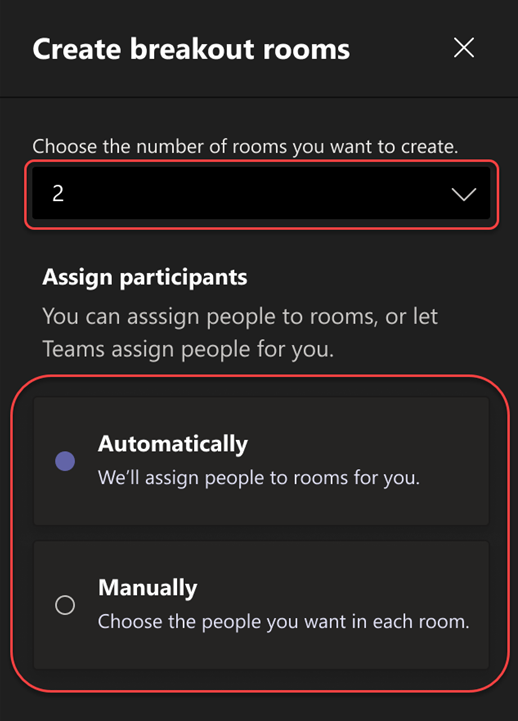
Make your meetings more efficient by adjusting breakout room settings before they start. Meeting organizers can plan ahead by creating and naming breakout rooms, sorting attendees into rooms, setting timers, and more.
To change breakout room settings for meetings you organized, you must first join the meeting:
Assign participants to each breakout room if you didn't do so automatically or need to reassign someone to another room. To assign people, you must be a meeting organizer or presenter who's been appointed a breakout rooms manager, and you must first join the meeting.

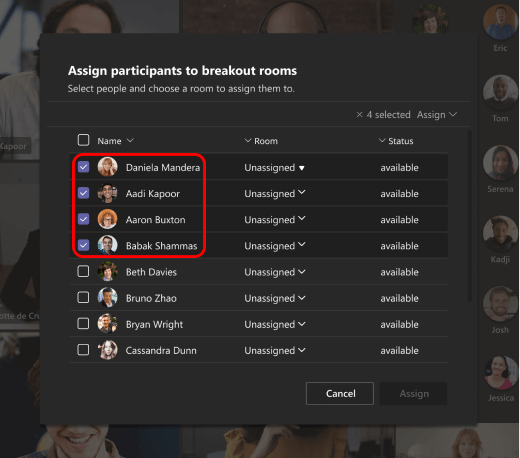 to breakout rooms" />
to breakout rooms" />
.
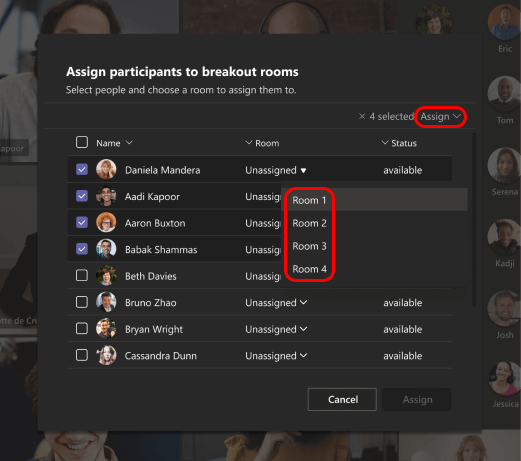
To assign channel members to breakout rooms before a channel meeting starts, you must first join the meeting:
Meetings with breakout room capabilities are limited to 300 participants. If the channel contains more than 300 members, pre-assignment will not be available. Meeting organizers can also assign participants to breakout rooms during the meeting.
Randomly assign participants to breakout rooms before and during a meeting. Shuffle everyone or just people who aren’t assigned to a room yet.
If you're the meeting organizer, you can delegate presenters to manage the meeting's breakout rooms.
Breakout rooms managers can:
Important: Only one person at a time can manage a meeting's breakout rooms.



. Select Room settings
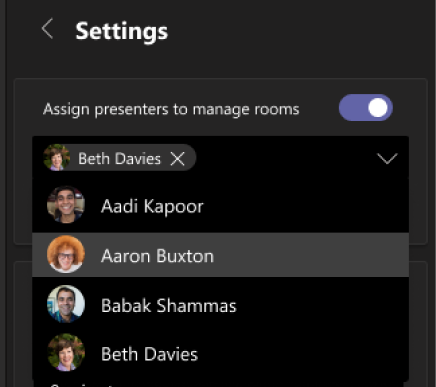
.
You might be one of a few breakout rooms managers in your meeting. Only one of you at a time can control the rooms, though.

If you want, rename each room to reflect its purpose (for example, what the people in that room will be working on).

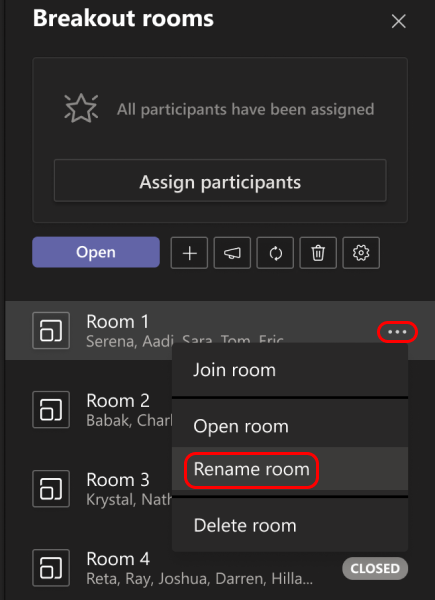
Tip: During the meeting, you can delete all the breakout rooms and set them up differently (see Recreate breakout rooms from scratch).
When you set a time limit, a timer is visible in each breakout room so that participants are aware of when the session will end. When time is up, the rooms close and participants return to the main meeting.
Note: If you turn off the Automatically move people to rooms setting (see Turn off automatic entry to breakout rooms), participants will have the option of either returning to the main meeting or leaving the meeting, when time is up.


. Select Rooms settings
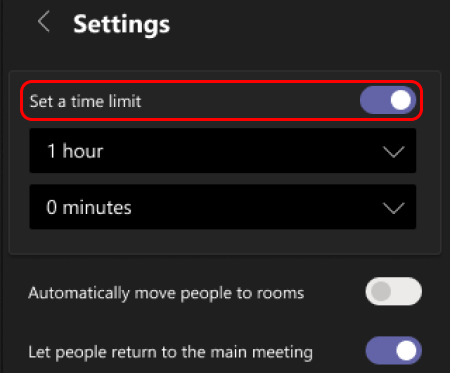
By default, meeting participants are moved to their assigned rooms as soon as you open them, but you can turn off this setting (see Turn off automatic entry to breakout rooms).

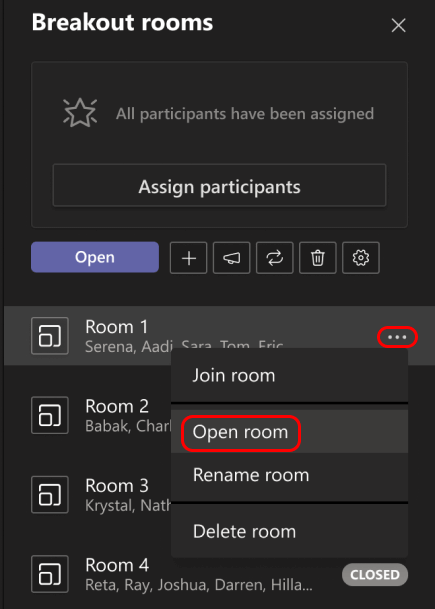
.
You can open and close breakout rooms more than once during a meeting.
If you're the meeting organizer or a breakout rooms manager, you can join any of the rooms.

In the meeting controls, select Return.
As meeting organizer, you can send announcements to all the breakout rooms and contribute to any of the room chats.
You may want to tell everyone what the remaining breakout session time is, offer discussion ideas, or just give general updates.


. Select Make an announcement
Participants are notified in their meeting chat to check for your announcement.
Each breakout room has its own chat. All of the chats are available in your main Teams Chat list. Here you can chat with the members of any breakout room.
After you join a breakout room, you can also select Chat

in the room to chat with the people there.
Note: When the breakout room closes, the room chat ends and can't be continued. However, you'll still be able to view the chat history and any shared files.
When you close the breakout rooms, the participants return to the main meeting.
Note: If you turned off the Automatically move people into opened rooms setting (see Turn off automatic entry to breakout rooms), participants will have the option of returning to the main meeting or leaving the meeting when the rooms are closed.


You'll know rooms have successfully closed when their status changes to Closed.
When everyone is back from their breakout rooms and you're ready to meet as a larger group again, select Resume.
Unless the organizer manually unassigns people from their breakout rooms, the same rooms and room assignments will be available for the next meeting.
If you organize a meeting, you can gain insight into its participants and their breakout room activity through attendance reports. Learn which breakout room each person has joined, when they entered it, and when they left.
To view breakout room data from a meeting:
To reference breakout room data later, download the attendance report in CSV format.
By default, participants are automatically moved into breakout rooms when they're opened. When you turn off this option, participants receive a message asking them to join a breakout room. They select Join room (Join on a mobile device) before being moved.


. Select Room settings
Meeting attendees can learn more about joining and participating in breakout rooms here: Join a breakout room in a Teams meeting.
By default, this setting is off. Turning it on gives participants the option to leave their breakout rooms and return to the original meeting to rejoin the larger discussion.


. Select Room settings
Participants can be moved when breakout rooms are open or closed.



. Select Add room



. Select Remove rooms
During a meeting, you can delete all the breakout rooms, create new ones, and reassign participants to them.


. Select Remove rooms